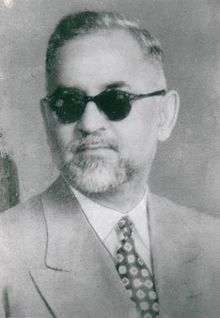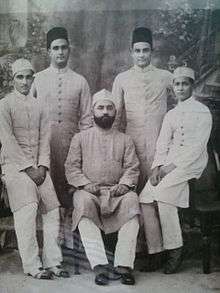Zakir Husain (politician)
| Zakir Husain | |
|---|---|
|
ज़ाकिर हुसैन ذاکر حسین | |
 | |
| 3rd President of India | |
|
In office 13 May 1967 – 3 May 1969 | |
| Prime Minister | Indira Gandhi |
| Vice President | Varahagiri Venkata Giri |
| Preceded by | Sarvepalli Radhakrishnan |
| Succeeded by | Varahagiri Venkata Giri (Acting) |
| 2nd Vice President of India | |
|
In office 13 May 1962 – 12 May 1967 | |
| President | Sarvepalli Radhakrishnan |
| Prime Minister |
Jawaharlal Nehru Lal Bahadur Shastri Indira Gandhi |
| Preceded by | Sarvepalli Radhakrishnan |
| Succeeded by | Varahagiri Venkata Giri |
| Governor of Bihar | |
|
In office 6 July 1957 – 11 May 1962 | |
| Chief Minister |
Krishna Sinha Deep Narayan Singh |
| Preceded by | R. R. Diwakar |
| Succeeded by | Madabhushi Ananthasayanam Ayyangar |
| Personal details | |
| Born |
8 February 1897 Hyderabad, Hyderabad State,[1] (now in Telangana, India) |
| Died |
3 May 1969 (aged 72) New Delhi, Delhi, India |
| Political party | Independent |
| Spouse(s) | Shahjehan Begum |
| Alma mater |
HMS Islamia, Etawah Aligarh Muslim University University of Delhi Humboldt University of Berlin |
| Awards |
|
Zakir Husain Khan (8 February 1897 – 3 May 1969) was the third President of India, from 13 May 1967 until his death on 3 May 1969. An educationist and intellectual, Husain was the country's first Muslim president, and also the first to die in office.
He previously served as Governor of Bihar from 1957 to 1962 and as Vice President of India from 1962 to 1967. He was also the co-founder of Jamia Milia Islamia, serving as its Vice Chancellor from 1928. Under Husain, Jamia became closely associated with the Indian freedom movement. He was awarded the Bharat Ratna, India's highest civilian honour, in 1963.
Family and early life

Husain was born in Hyderabad, Telangana, into a Pashtun family of the Afridi tribe,[2] which came to be more closely associated with Kaimganj in Farrukhabad district, Uttar Pradesh, and education and academia.[1][3][4] After Husain was born, his family migrated from Hyderabad to Kaimganj, where he grew up. He was the second of seven sons: the elder brother of fellow educationist Yousuf Husain. Husain's family would remain active in public life: his grandson Salman Khurshid, a Congress politician, is the former Foreign Minister of India, and his nephew was the noted academic Masud Husain.[5] His brother Mahmud Husain joined the Pakistan Movement and served as Education Minister, while his nephew Anwar Husain was director of Pakistan Television. His relation Rahimuddin Khan served as Chairman Joint Chiefs of Staff Committee of the Pakistan Army and as provincial governor.[6]
Husain's father, Fida Husain Khan, died when he was ten years old; his mother died in 1911 when he was fourteen. Husain's early primary education was completed in Hyderabad,[7] He completed High school from Islamia High School, Etawah, and was then educated at the Muhammadan Anglo-Oriental College, now Aligarh Muslim University, where he was a prominent student leader.[8] He received his doctorate in economics from the University of Berlin in 1926.[9] In 1915, at the age of 18, he married Shah Jahan Begum and had two daughters, Sayeeda Khan and Safia Rahman.[10]
Career
When Hussain was 23 years old, with a group of students and teachers he founded the National Muslim University, first founded in Aligarh on Friday 29 October 1920 then shifted to Karol Bagh, New Delhi in 1925, then later shifted again on 1 March 1935 to Jamia Nagar, New Delhi and named it Jamia Millia Islamia (a central university). He subsequently went to Germany to obtain a PhD from the Frederick William University of Berlin in Economics. While in Germany, Husain was instrumental in bringing out the anthology of arguably the greatest Urdu poet Mirza Assadullah Khan "Ghalib" (1797–1868).[11]
He returned to India to head the Jamia Millia Islamia which was facing closure in 1927. He continued in that position for the next twenty-one years providing academic and managerial leadership to an institution that was intimately involved with India's struggle for freedom from the British Rule and experimented with value-based education on the lines advocated by Mahatma Gandhi and Hakim Ajmal Khan.[12] During this period he continued to engage himself with movements for educational reforms in India and was particularly active in the affairs of his old alma mater the MAO College, now the Aligarh Muslim University. During this period Hussain emerged as one of the most prominent educational thinkers and practitioners of modern India. His personal sacrifice and untiring efforts to keep the Jamia afloat in very adverse circumstances won him appreciation of even his arch political rivals like Mohammed Ali Jinnah.
Soon after India attained independence, Husain agreed to be the Vice chancellor of the Aligarh Muslim University which was facing trying times in post partition India because of active involvement of a section of its teachers and students in the movement for creation of Pakistan. Dr. Husain, again, provided leadership during a critical phase of the history of the University at Aligarh from 1948–1956. Soon after completing his term as Vice Chancellor he was nominated as a member of the Upper House of Indian Parliament in 1956, a position he vacated in 1957 to become Governor of the State of Bihar.
After serving as the Governor of Bihar from 1957 to 1962, and as the second Vice President of India from 1962 to 1967, Husain was elected President of India on 13 May 1967. In his inaugural speech, he said that the whole of India was his home and all its people were his family.[13] During his last days, the issue of nationalization of banks was being hotly debated. The bill, in the end, received presidential consent from Mohammad Hidayatullah, (acting president) on 9 August 1969.[14]
During his presidential tenure, Zakir Husain led four state visits to Hungary, Yugoslavia, USSR and Nepal.[15]
Husain died on 3 May 1969, the first Indian President to die in office. He is buried along with his wife (who died some years later) on the campus of Jamia Millia Islamia in New Delhi.
With the main objective of providing facility for higher education in Ilayangudi, a college was started in his honour in 1970.[16]
The Engineering College of Aligarh Muslim University is named after him.[17]
- Zakir Husain's Mausoleum in Jamia Millia Islamia.
- The grave of Zakir Husain.
- Interior view of the Mausoleum of Zakir Husain and his wife, ShahJahan Begum.
- Angle view of the Mausoleum through which the grave of Zakir Husain can be seen.
- Interior view with an angle of the mausoleum of Zakir Husain.
- Interior view with an angle of the mausoleum of Zakir Husain.
References
- 1 2 Zakir Husain, Encyclopædia Britannica Online, 12 February 2012, retrieved 13 May 2012
- ↑ Manjapra, Kris (2014). Age of Entanglement. United States: Harvard University Press. p. 160. ISBN 067-4-72631-6.
- ↑ "History under threat". The Hindu. 10 October 2011. Retrieved 10 December 2012.
- ↑ Sharma, Vishwamitra (2007). Famous Indians of the 21st century. Pustak Mahal. p. 60. ISBN 81-223-0829-5. Retrieved 18 September 2010
- ↑ "After controversy, crowning glory for Khurshid". The Hindu. 29 October 2012. Retrieved 10 December 2012.
- ↑ [ https://bharatmatamandir.in/?p=71]
- ↑ "Former president Hussain was alumni of 150 year old school in Hyderabad". Deccan Chronicle. 13 March 2016. Retrieved 21 March 2017.
- ↑ Fārūqī, Z̤iāʼulḥasan (1999). "Dr. Zakir Husain, quest for truth". Chapter 2 – Islamia High School Etawah. APH Publishing. Retrieved 20 October 2010.
- ↑ "Zakir Husain". Retrieved 10 December 2012.
- ↑ Jai, Janak Raj (2003). Presidents of India: 1950-2003. New Delhi: Regency Publications. p. 52.
- ↑ Zakir Saheb by Hakim Syed Zillur Rahman, Zakir Sahab Zatti Yadain, Edited by Dr. Abid Raza Bedar, Khuda Bakhsh Oriental Library, Patna, 1993, p. 165-168
- ↑ Zakir Sahab Aur Hakim Ajmal Khan by Hakim Syed Zillur Rahman, Dr. Zakir Husain Khan – Hayat, Fikr Aur Aman, Edited by Professor Abdul Ghaffar Shakil & Dr. Khaliq Anjum, Karnataka Urdu Academy, Bangalore, 1999. p. 157-174
- ↑ Zakir Sahib ki Insan Dosti by Hakim Syed Zillur Rahman, Dr. Zakir Husain Hayat wa Khidmat, Khuda Bakhsh Oriental Library, Patna, 2000, page 97-108
- ↑ Shashi Thoroor The Great Indian Novel, page 347
- ↑ "DETAILS OF MEDIA PERSONS ACCOMPANYING THE PRESIDENT IN HIS/HER VISITS ABROAD SINCE 1947 TO 2012" (PDF). The President's Secretariat. Retrieved 5 June 2013.
- ↑ http://www.drzhcily.com/
- ↑ http://engg.amu.ac.in/about-zhcet.html
External links
| Wikiquote has quotations related to: Zakir Husain (politician) |
| Political offices | ||
|---|---|---|
| Preceded by R. R. Diwakar |
Governor of Bihar 1957–1962 |
Succeeded by Madabhushi Ananthasayanam Ayyangar |
| Preceded by Sarvepalli Radhakrishnan |
Vice President of India 1962–1967 |
Succeeded by Varahagiri Venkata Giri |
| President of India 1967–1969 | ||
| Academic offices | ||
|---|---|---|
| Preceded by Zahid Husain |
Vice-Chancellor of AMU 1948-1956 |
Succeeded by Bashir Husain Zaidi |

